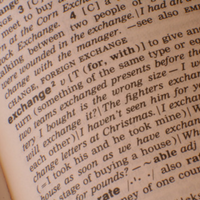What to know about receiving a money transfer
24-12-2020 | treasuryXL | XE |
Just like sending one, receiving an international money transfer is quick and simple. Here’s what you’ll need to know about receiving your money transfer.
Need to send money overseas? You’re in luck. There is no shortage of resources available to help people send money electronically across national borders. And it’s understandable: this process is often cumbersome and difficult to understand.
Now, if you’re receiving the transfer? Not so much. There is very little out there to help recipients. It’s almost like companies assume that recipients are financially savvy and they already know everything, or that receiving a money transfer couldn’t potentially be confusing for a first-time recipient.
At Xe, we assume nothing. We’re here to offer step-by-step assistance for both senders and recipients. Our mission is to complete international electronic funds transfers as efficiently as possible, and make the process as quick and easy as possible for anyone who needs to do it.
We’ll go into further detail below, but here are the basics of what you’ll need to know as someone expecting an international money transfer:
-
Have a bank account
-
Provide the necessary information
-
Wait for the money to transfer
-
Watch your bank account
1. Have a bank account
A significant number of readers took a deep breath when they saw that requirement. About one in ten American adults do not have a bank account. They only use cash or they only use prepaid debit cards. These alternatives are usually just fine, but an electronic money transfer is different. No cash changes hands, and the paying party usually cannot add funds to a debit card.
Most of these people are able to open bank accounts. The minimum requirements are not terribly burdensome. Instead, fear keeps many of these people from opening accounts. They are afraid their credit scores are not high enough or they are subject to a bank account levy order.
Yes, many bank accounts, especially interest-bearing accounts, have minimum credit score requirements. These minimum requirements are also rather high. However, many banks also offer no credit check bank accounts. Typically, these banks do not run ChexSystem reports either. So, the current bank does not know if you owe money to another bank. These accounts usually have rather high fees and other stipulations. But, even if you have the world’s lowest credit score, a bank account is probably available (though bank account levies are another matter).
2. Provide the necessary information
Many people do not like to share their personal information with anyone for any reason. We understand that attitude; there are quite a few scammers out there. However, if you want to receive an money transfer, you’ll need to give the sender some information. We can’t transfer money if we don’t know where to transfer it, after all!
The requirements vary according to the transfer platform. If you’ll be receiving an Xe money transfer, your sender will need:
-
Your name and address. Use your legal name (the name connected to your bank account) and not the name you go by. Furthermore, most financial institutions require recipients to have physical addresses as opposed to post office box numbers. This is for security and anti-money laundering purposes.
-
Your country. A no-brainer, right? But there are two Chinas and two Koreas. Some people live in breakaway republics, such as South Sudan and Tigray, that are not universally recognized. Many also people live in disputed zones which are claimed by multiple countries, such as the India-Pakistan border. Bottom line: the country must match the sender’s financial institution’s records.
-
Your bank information. We need to know it so we know where to deposit the money. This data usually includes:
-
Your bank name
-
Your bank account number
-
A SWIFT or BIC code (which you can get with a quick Google search)
-
If possible, try not to send this information via unencrypted cell phone text message. Use email or something more secure. And don’t forget to double-check your information, especially account numbers. It’s very easy to transpose digits or make another minor error that could have a big impact. If that happens, you’ll need to wait even longer to receive the transfer, and odds are, that’s not what you want.
3. Wait for the money to transfer
Domestic transfers are usually almost instant. We get nervous if PayPal takes more than thirty seconds to move money. A few international transactions are almost that fast, but most take more time.
Currency conversion accounts for much of this delay. There are many different currency markets that convert U.S. dollars to Mexican pesos, Italian liras to Russian rubles, and so on. These markets charge different fees. Frequently, the transferring financial institution looks for the highest price, adds that fee to the transaction, uses a lower-priced market, and pockets the difference.
Not so at Xe. Our international funds transfer fees are entirely transparent. Nothing happens under the table. So, you know how much money you are going to receive before the sender actually sends it.
Network infrastructure also accounts for some delays. Many banks have excellent services for their local customers, but they do not handle very many international transfers. These transfers are often risky, largely because of the aforementioned international recognition and boundary issues.
Once again, these delays are usually not a problem at Xe. International funds transfers are all we do, so we know how to handle them efficiently and securely (another reason why international transfers can take a little longer—we’re ensuring everything is secure before we transfer).
Generally, Xe transfers require between 1-4 business days to complete (though most transfers are complete within 24 hours, and some take just a few minutes). That’s about the same speed as a domestic PayPal bank transfer.
But you won’t need to resort to guesswork. When your sender confirms their transfer, they’ll be given an expected completion date, and update that time estimate if necessary by email. The sender usually has the most up-to-date information, so check with them!
4. Watch your bank account
International transfers are entirely electronic. We typically send alerts to senders when we begin processing transfers, if there are any hiccups, and when the transfer is complete. We normally also send completion alerts to recipients, assuming we have a good email address.
The best way to know when a transfer is complete is to watch your bank account activity. Occasionally, recipient financial institutions place holds on these transactions, but that’s between you and your bank.
Get in touch with XE.com
About XE.com
XE can help safeguard your profit margins and improve cashflow through quantifying the FX risk you face and implementing unique strategies to mitigate it. XE Business Solutions provides a comprehensive range of currency services and products to help businesses access competitive rates with greater control.
Deciding when to make an international payment and at what rate can be critical. XE Business Solutions work with businesses to protect bottom-line from exchange rate fluctuations, while the currency experts and risk management specialists act as eyes and ears in the market to protect your profits from the world’s volatile currency markets.
Your company money is safe with XE, their NASDAQ listed parent company, Euronet Worldwide Inc., has a multi billion-dollar market capitalization, and an investment grade credit rating. With offices in the UK, Canada, Europe, APAC and North America they have a truly global coverage.
Are you curious to know more about XE?
Maurits Houthoff, senior business development manager at XE.com, is always in for a cup of coffee, mail or call to provide you detailed information.
Visit XE.com
Visit XE partner page










